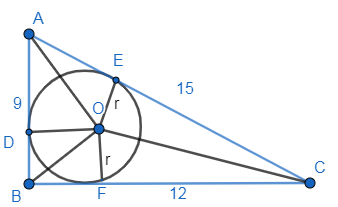
A circle is inscribed in a triangle with sides 9, 12 and 15. The radius of the circle is
Answer
610.5k+ views
Hint: To find the radius of the incircle, first find the area of the triangle using the formula, $\dfrac{1}{2}\times \text{base}\times \text{height}$
Here we have to find the radius of a circle inscribed in a triangle of sides 9, 12, 15.
Complete step-by-step answer:
The sides of the triangle given in the question are 9, 12, 15.
Let AB = 9, BC = 12, CA = 15.
Now we will check whether the given triangle is a right angled triangle. For this we will use Pythagoras theorem.
$A{{B}^{2}}+B{{C}^{2}}=A{{C}^{2}}$
Substituting the corresponding values, we get
$\begin{align}
& {{9}^{2}}+{{12}^{2}}={{15}^{2}} \\
& \Rightarrow 81+144=225 \\
& \Rightarrow 225=225 \\
\end{align}$
Hence, we can see that the given triangle satisfies Pythagoras theorem, so the given triangle is a right angled triangle. So, the corresponding diagram will be,

So, let the circle inscribed in the triangle ABC have the radius as ‘r’ and ‘O’ be the centre of the circle.
WE can see from the figure that the radius of the inscribed circle is perpendicular to the corresponding sides, so OD, OF, OE are perpendicular to AB, BC and AC respectively.
Now from figure, we can also say that
Area of triangle ABC = Area of triangle AOB + Area of triangle BOC + Area of triangle COA
Now we know the area of the triangle = ½ times base times height. So we can write it as,
$\begin{align}
& \Delta ABC=\Delta AOB+\Delta BOC+\Delta COA \\
& \Rightarrow \dfrac{1}{2}\times AB\times BC=\dfrac{1}{2}\times OD\times AB+\dfrac{1}{2}\times OF\times BC+\dfrac{1}{2}\times OE\times AC \\
\end{align}$
Substituting values from the above figure, we get
$\Rightarrow \dfrac{1}{2}\times 9\times 12=\dfrac{1}{2}\times r\times 9+\dfrac{1}{2}\times r\times 12+\dfrac{1}{2}\times r\times 15$
Cancelling the like terms, we get
$\begin{align}
& \Rightarrow 108=9r+12r+15r \\
& \Rightarrow 108=36r \\
& \Rightarrow r=\dfrac{108}{36}=3 \\
\end{align}$
Hence the radius of the inscribed circle is 3.
Note: Another approach for this problem is using the formula,
$\text{radius}=\left( \dfrac{a+b-c}{2} \right)$
Here a and b are the sides and c is the hypotenuse of the right angled triangle.
This is used when the circle is inscribed in a right angled triangle.
Here we have to find the radius of a circle inscribed in a triangle of sides 9, 12, 15.
Complete step-by-step answer:
The sides of the triangle given in the question are 9, 12, 15.
Let AB = 9, BC = 12, CA = 15.
Now we will check whether the given triangle is a right angled triangle. For this we will use Pythagoras theorem.
$A{{B}^{2}}+B{{C}^{2}}=A{{C}^{2}}$
Substituting the corresponding values, we get
$\begin{align}
& {{9}^{2}}+{{12}^{2}}={{15}^{2}} \\
& \Rightarrow 81+144=225 \\
& \Rightarrow 225=225 \\
\end{align}$
Hence, we can see that the given triangle satisfies Pythagoras theorem, so the given triangle is a right angled triangle. So, the corresponding diagram will be,

So, let the circle inscribed in the triangle ABC have the radius as ‘r’ and ‘O’ be the centre of the circle.
WE can see from the figure that the radius of the inscribed circle is perpendicular to the corresponding sides, so OD, OF, OE are perpendicular to AB, BC and AC respectively.
Now from figure, we can also say that
Area of triangle ABC = Area of triangle AOB + Area of triangle BOC + Area of triangle COA
Now we know the area of the triangle = ½ times base times height. So we can write it as,
$\begin{align}
& \Delta ABC=\Delta AOB+\Delta BOC+\Delta COA \\
& \Rightarrow \dfrac{1}{2}\times AB\times BC=\dfrac{1}{2}\times OD\times AB+\dfrac{1}{2}\times OF\times BC+\dfrac{1}{2}\times OE\times AC \\
\end{align}$
Substituting values from the above figure, we get
$\Rightarrow \dfrac{1}{2}\times 9\times 12=\dfrac{1}{2}\times r\times 9+\dfrac{1}{2}\times r\times 12+\dfrac{1}{2}\times r\times 15$
Cancelling the like terms, we get
$\begin{align}
& \Rightarrow 108=9r+12r+15r \\
& \Rightarrow 108=36r \\
& \Rightarrow r=\dfrac{108}{36}=3 \\
\end{align}$
Hence the radius of the inscribed circle is 3.
Note: Another approach for this problem is using the formula,
$\text{radius}=\left( \dfrac{a+b-c}{2} \right)$
Here a and b are the sides and c is the hypotenuse of the right angled triangle.
This is used when the circle is inscribed in a right angled triangle.
Recently Updated Pages
A Paragraph on Pollution in about 100-150 Words

A boat goes 24 km upstream and 28 km downstream in class 10 maths CBSE

Three beakers labelled as A B and C each containing 25 mL of water were taken A small amount of NaOH anhydrous CuSO4 and NaCl were added to the beakers A B and C respectively It was observed that there was an increase in the temperature of the solutions contained in beakers A and B whereas in case of beaker C the temperature of the solution falls Which one of the following statements isarecorrect i In beakers A and B exothermic process has occurred ii In beakers A and B endothermic process has occurred iii In beaker C exothermic process has occurred iv In beaker C endothermic process has occurred

The selling price of 16 spoons is equal to the cost class 8 maths CBSE

Choose the correct statement about inflammable substances class 8 chemistry CBSE

Two figures can have the same area but different perimeters class 9 maths CBSE

Trending doubts
The average rainfall in India is A 105cm B 90cm C 120cm class 10 biology CBSE

Why is there a time difference of about 5 hours between class 10 social science CBSE

What is the median of the first 10 natural numbers class 10 maths CBSE

Who Won 36 Oscar Awards? Record Holder Revealed

Indias first jute mill was established in 1854 in A class 10 social science CBSE

Indias first jute mill was established in 1854 in A class 10 social science CBSE




